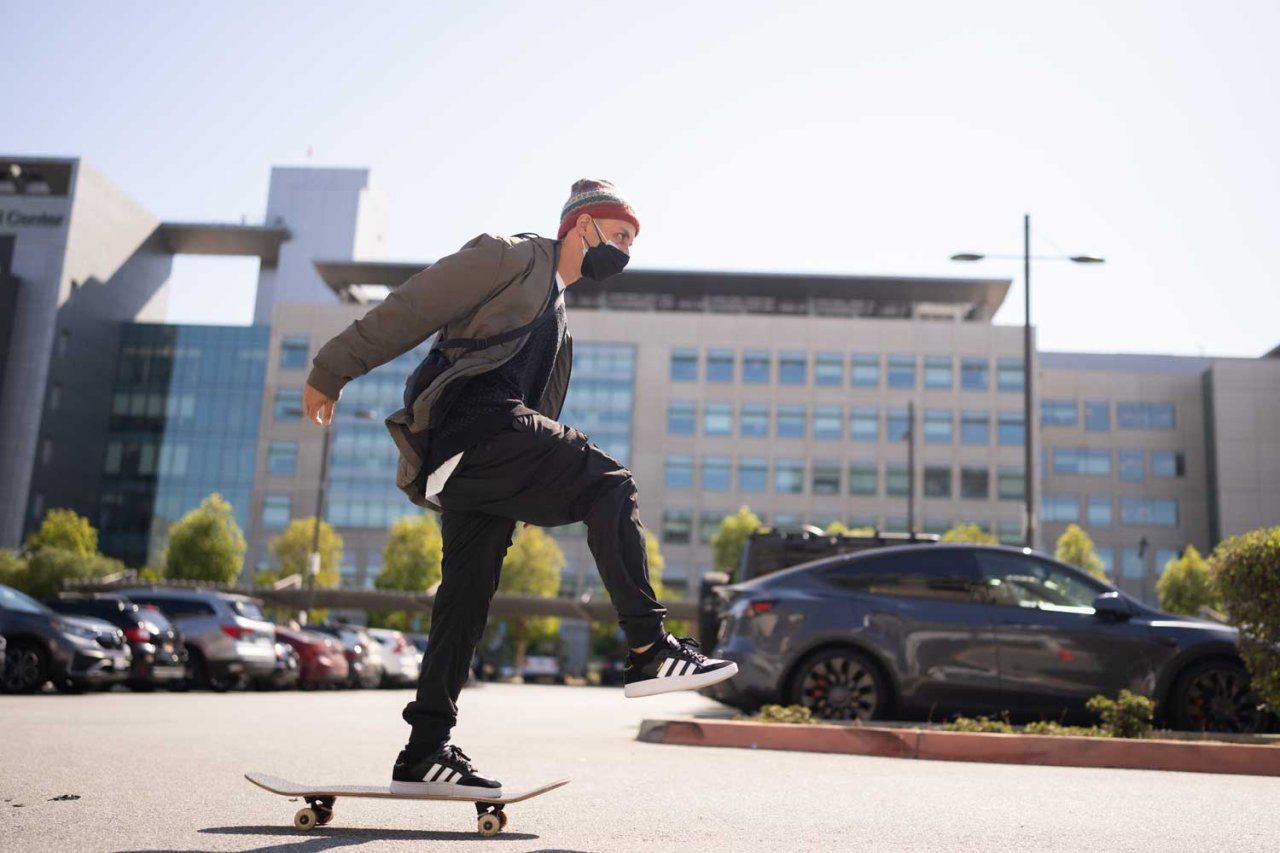
Shawn Connolly was 39 years old and a professional skateboarder when he noticed his hands starting to clench unintentionally. He was also having bouts of stiffness and couldn’t move as well as he used to.
“I mistakenly thought it was aging,” Connolly said. “I’ve had sciatic problems and bad joints, like most athletes. But it turned out to be a little more than that.”
A doctor diagnosed him in 2015 with early-onset Parkinson’s disease and recommended he go to the UCSF Movement Disorders and Neuromodulation Clinic, which is renowned for its cutting-edge care in the field.
The clinic’s co-director, Philip Starr, MD, PhD, was just beginning to work on a new self-adjusting pacemaker for the brain that held the promise of stemming Connolly’s symptoms.
Brain implants are widely used to treat Parkinson’s, a progressive neurological disease that affects 1 million people in the U.S. and 10 million around the world. But the technology currently available to patients is decades-old and no match for the ever-changing symptoms of the disease, which can vary from slowness and rigidity to waves of involuntary movement.
Starr’s approach, called adaptive deep brain stimulation, or aDBS, responds to a person’s symptoms in real time. Using data techniques and algorithms developed in the lab of Simon Little, MBBS, PhD, assistant professor of neurology and a member of the UCSF Weill Institute for Neurosciences, the device picks up on brain signals that indicate a symptom is developing and delivers just the right amount of electrical stimulation to stop it.
Connolly had landed at one of the few places in the world where patients like him could have the opportunity to participate in a trial of this experimental technology.
“Not all medical centers are willing to support surgeries that use investigational devices,” said Starr, the Dolores Cakebread Professor of Neurological Surgery, who is also at the Weill Institute. “UCSF has a tradition of bringing investigational treatments like this into the clinical setting.”


“I was so young,” Connolly said. “People didn’t look at me and say, ‘Oh, that guy’s got Parkinson’s.’”
Skateboarding with Parkinson’s disease. See how Shawn’s adaptive deep brain stimulation (aDBS) device helped get him back on his feet. Video produced by Maurice Ramirez and Pete Bell
Difficult diagnoses for a young couple
Most people develop Parkinson’s in their 50s to 70s. Connolly was one of the unlucky few who got it much earlier.
At first, his symptoms were mild enough that he could continue his work with the San Francisco Skate Club, a beloved neighborhood clubhouse he founded in 2007 with his wife Thuy Nguyen, a former teacher. Operating out of a storefront in San Francisco’s Western Addition, their door was open to any kid who wanted to learn how to skate, needed help with homework or just needed some groceries to take home. They offered skateboard classes and camps, hired some of their graduates, and served about 100 San Francisco kids a year.

“Through skateboarding, we nurture their natural abilities and channel that wonderment we all have for life,” Connolly said. “It’s a catalyst for opening up their minds to new challenges and new options.”
Then, in 2019, Nguyen was diagnosed with cancer.
“I pretty much swept my own issues under the rug, I just had to do what I had to do to get through it and be there for her,” Connolly said. “We were in survival mode for a long time.”
Nguyen died in November of the following year.
By that time, Connolly was walking with a cane, which he carried while riding on his skateboard. He had trouble writing in his journal and strangers were suspicious of his erratic, involuntary movements.
“I was so young,” Connolly, who is now 48. “People didn’t look at me and say, ‘Oh, that guy’s got Parkinson’s.’”
Connolly’s symptoms were fluctuating between bradykinesia, the rigidity and sluggishness characteristic of Parkinson’s, and dyskinesia, involuntary wiggles that are a side effect of medication.
“It was almost unbearable,” he said. “Sometimes I was so stiff I couldn’t even turn over in bed. I’d have to pick a position and try to sleep that way the whole night, only getting four or five hours of sleep.”
While Connolly’s disease progressed, Starr and Little continued working to make their adaptive DBS a reality.
They identified signals in the brain to indicate Parkinson’s symptoms were brewing and developed technology that could direct the device to send just enough electrical stimulation to prevent them.
By 2021, they were ready to test it. Connolly decided to join their clinical trial.
Fixing fluctuations
Parkinson’s is associated with the loss of brain cells that produce dopamine, a neurotransmitter that is required for movement, as well as attention, balance, memory, motivation and sleep.
Doctors prescribe levodopa to replace the missing dopamine, but the medication can also cause symptoms to fluctuate between too much and too little movement, as the drug comes on strong and then wears off.
The new aDBS technology is designed to sense these symptoms before they occur and calibrate the amount of stimulation needed to prevent them.
Connolly scheduled his surgery for March 2021 and told the kids at the skate club.
“It was difficult for me to rally to have that discussion,” he said. “But I knew they’d be able to see the before and after, and they’d understand that sometimes it takes difficult things, like surgery, to get you where you need to be.”
Starr inserted wires into the regions of Connolly’s brain that fine-tune movement and placed electrodes on its surface. The sensors pick up Connolly’s brain activity and send it through another set of wires running down the back of his head and neck to two small, data-analyzing devices implanted over his pectoral muscles.
The surgery took eight hours. But it was just the beginning.
Connolly felt better as soon as the device switched on, and he was able to reduce his medication. But the device was not yet capable of sensing his symptoms, and he still struggled with motor fluctuations. He could make crude adjustments to the stimulation using a hand-held device, but the process involved a lot of self-monitoring and guesswork and often was not effective.
The researchers still needed to create and refine the algorithms to enable the DBS device to respond to Connolly’s symptoms, a process that took nearly a year. Three postdocs in Starr’s lab, Carina Oehrn, MD, PhD, Stephanie Cernera, PhD, and Lauren Hammer, MD, PhD, analyzed Connolly’s brain signals remotely and found a brain wave signal they could use to track his symptoms as he went about his everyday life.
“It was crazy,” Connolly said. “I’d be streaming my brain data to them while I’m hanging out getting work done at my house.”
After about a year, the team developed an algorithm that could spot Connolly’s symptoms as they occurred and adjust his stimulation accordingly. He got his personal algorithm in late 2023.
“I had no motor fluctuations for eight hours straight,” he said. “I felt fine. I went for a long walk. I drove. I came home and made dinner, all that stuff.”
Return of good days
Since Parkinson’s patients tend to alternate between opposing symptoms, the trick was getting the device to look out for both extremes at once.
“We measured brain signals of under-stimulation and over-stimulation and, using those, could program the pacemaker to improve symptoms on one end of the spectrum without tipping too far and triggering symptoms on the other end,” Little said.
The new technology also worked for others in the trial, reducing the movement symptom that bothered them the most by an average of 50%, and significantly improving their quality of life. The results were published Aug. 19, 2024 in Nature Medicine.
The research team still is not finished, and they continue refining his algorithm.
“When something doesn’t feel right, I send them a text, and they send me a new download,” Connolly said. “Knowing they’re right there like that really puts me at ease.”
He got a sense of just how much the device was doing for him one day when he forgot to charge the battery, and it stopped working.
“I could barely move, my bradykinesia was so bad,” he said. “It was the worst I’ve ever felt.”
He somehow managed to recharge the device enough to get it to turn back on.
“I felt better right away. That really showed me the benefits of this technology.”
Connolly looks forward to resuming his deeper involvement with the Skate Club now that he has enough energy to run the summer skate camps.
“It’s definitely changed my life,” he said. “I can just go through the whole day feeling good.”
